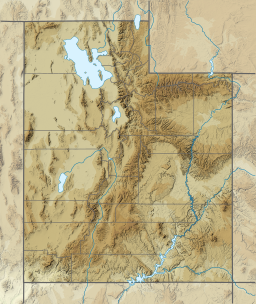| Utah Lake | |
|---|---|
 Satellite photo of Utah Lake | |
| Location | Utah County, Utah, United States |
| Coordinates | 40°13′12″N 111°48′00″W / 40.22000°N 111.80000°W |
| Type | slightly saline Eutrophic[1] |
| Primary inflows | American Fork, Provo River, Hobble Creek, and Spanish Fork |
| Primary outflows | Jordan River and evaporation |
| Catchment area | 3,846 sq mi (9,960 km2)[2] |
| Basin countries | United States |
| Managing agency | State of Utah |
| Max. length | 24 mi (39 km)[3] |
| Max. width | 13 mi (21 km)[3] |
| Surface area | 95,000 acres (380 km2)[4] |
| Average depth | 10.5 ft (3.2 m)[5] |
| Max. depth | 14 ft (4.3 m)[5] |
| Water volume | 870,000 acre⋅ft (1.07×109 m3)[4] |
| Surface elevation | 4,489 ft (1,368 m) (compromise)[4] |
| Islands | 1 |
| Settlements | Provo-Orem metropolitan area |
| Website | utahlake |
Utah Lake is a shallow freshwater lake in the center of Utah County, Utah, United States. It lies in Utah Valley, surrounded by the Provo-Orem metropolitan area. The lake's only river outlet, the Jordan River, is a tributary of the Great Salt Lake. Evaporation accounts for 42% of the lake's outflow, which leaves the lake slightly saline. The elevation of the lake is at 4,489 feet (1,368 m) above sea level. If the lake's water level rises above that, the pumps and gates on the Jordan River are left open. Recently the lake has been at a lower level because of a drought.

The first European to see Utah Lake was Father Silvestre Vélez de Escalante in 1776. He stayed with the Timpanogots band of Ute Tribe for three days. Mormon settlers later settled near the lake beginning in 1849, with the Timpanogots becoming mostly displaced from the area by 1872. The native fish species of the lake were overharvested by the settlers and subsequently restocked with non-native species.
Although thirteen species of fish were native to the lake, only the Utah sucker[6] and the critically endangered June sucker[7] remain. The dominant species in the lake is the common carp, introduced in 1883 as an alternative to the overharvested native fish. The carp is now estimated at 90% of the biomass of the lake and contributes to a decline in native fish populations by severely altering the ecosystem. Pollution has also caused problems with the lake's ecosystem. Raw sewage was dumped into the lake as late as 1967. Pollution problems still remain; the lake's phosphorus and mineral salt levels are in violation of the Clean Water Act. In recent years, the lake has been prone to harmful algal blooms or HABs.[8][9]
Utah Lake is managed cooperatively by the Utah Division of Forestry, Fire & State Lands and the Utah Lake Authority. The Division manages public use and issues a permit for commercial users of the lakebed and shoreline while the Commission facilitates development. The lakebed and surrounding shoreline are made up of State Sovereign Lands. Utah Lake is one of three lakes in the state that were deemed "navigable" at statehood and granted to the State of Utah.[10] Sovereign lands are managed under the public trust doctrine.
The Utah State Legislature has designated the Division of Forestry, Fire & State Lands as the executive authority for the management of sovereign lands and the state's mineral estates on lands other than school and institutional trust lands. Sovereign lands are defined by the Utah State Legislature as "those lands lying below the ordinary high water mark of navigable bodies of water at the date of statehood and owned by the state by virtue of its sovereignty."[11]
The Commission was created by State statute in Utah's 2007 General Legislative Session, House Concurrent Resolution 1, under the authority of the Interlocal Cooperation Act. The Commission is funded and empowered by 17 area governments, including; Utah County and its municipalities, the Central Utah Water Conservancy District, and three state agencies. Founded in 2007, the Commission seeks to promote multiple public uses of the lake, facilitate orderly planning and development in and around the lake, and enable individual Commission members to govern their own areas.
- ^ Fuhriman et al. 1981, p. 43
- ^ Cite error: The named reference
watershedwas invoked but never defined (see the help page). - ^ a b Utah Lake, June Sucker Recovery Implementation Program, archived from the original on October 12, 2009, retrieved April 10, 2010
- ^ a b c Cite error: The named reference
Lake statwas invoked but never defined (see the help page). - ^ a b Cite error: The named reference
Lake depthwas invoked but never defined (see the help page). - ^ COLE, D. D.; MOCK, K. E.; CARDALL, B. L.; CROWL, T. A. (December 2008). "Morphological and genetic structuring in the Utah Lake sucker complex". Molecular Ecology. 17 (24): 5189–5204. Bibcode:2008MolEc..17.5189C. doi:10.1111/j.1365-294x.2008.03990.x. ISSN 0962-1083. PMID 19067800. S2CID 34427341.
- ^ Strohm, Deanna D.; Budy, Phaedra; Crowl, Todd A. (2017-05-22). "Matching Watershed and Otolith Chemistry to Establish Natal Origin of an Endangered Desert Lake Sucker". Transactions of the American Fisheries Society. 146 (4): 732–743. Bibcode:2017TrAFS.146..732S. doi:10.1080/00028487.2017.1301994. ISSN 0002-8487.
- ^ Randall, Matthew C.; Carling, Gregory T.; Dastrup, Dylan B.; Miller, Theron; Nelson, Stephen T.; Rey, Kevin A.; Hansen, Neil C.; Bickmore, Barry R.; Aanderud, Zachary T. (2019). "Sediment potentially controls in-lake phosphorus cycling and harmful cyanobacteria in shallow, eutrophic Utah Lake". PLOS ONE. 14 (2): e0212238. Bibcode:2019PLoSO..1412238R. doi:10.1371/journal.pone.0212238. PMC 6375609. PMID 30763352. S2CID 67857832.
- ^ "Utah Lake Study 2018 State of the Environment Report (WQ)". Utah Department of Environmental Quality. 2019-01-02. Retrieved 2020-03-25.
- ^ "Utah State Code".
- ^ State of Utah. "Utah Division of Forestry, Fire & State Lands". Utah DNR.

